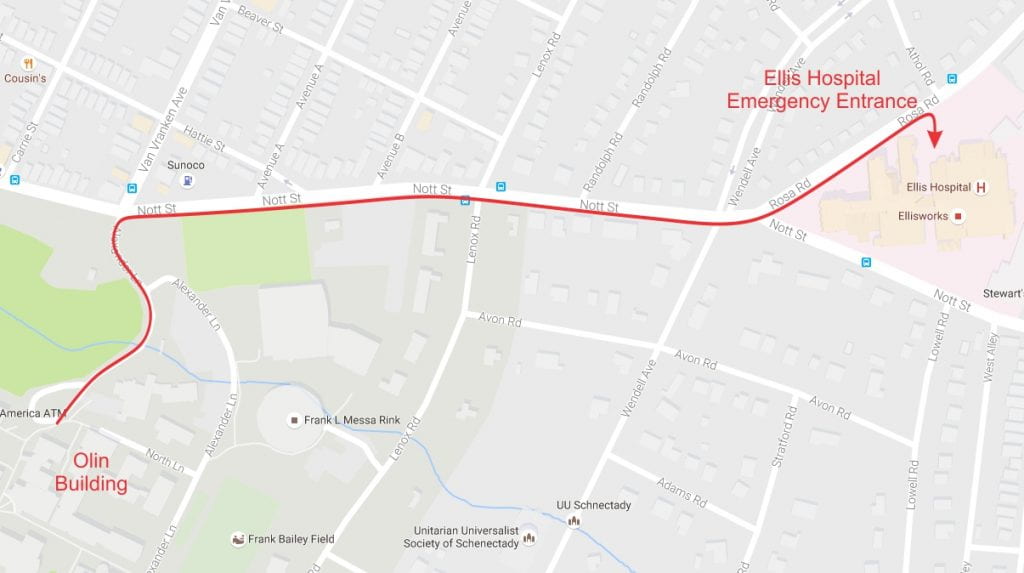HF is the most hazardous material we use in our lab
- Ellis Hospital Emergency Room
- Phone 518-243-4121
- the lab phone requires a 3 before the number.
- Go out the north (Nott St.) gate.
- Turn right onto Nott St.
- At the 5-way intersection with the lights, with Ellis Hospital right in front of you, bear left to the north side of Ellis Hospital.
- Look for the sign Emergency Entrance.

Exposure of only 2% of your body to concentrated HF can lead to death. It is lethal at concentrations of only 50 ppm in air. Fluoride ions bind rapidly to electrolyte ions in your tissues (e.g., Ca2+), causing severe electrolyte imbalance. Death can occur in as little as 30 minutes. Death is usually from massive organ failure (heart failure, etc.). If you don’t die quickly you will develop severe burns, excruciating pain, and possibly severe bone damage. The idea that HF primarily affects your bones is a common misunderstanding. Bone problems only develop if you survive.
- Always use HF in a fume hood!
- Always pay close attention to yourself and your work!
- Concentrated HF on your skin may initially go unnoticed, because it may cause no initial pain like strong acids do.
- HF quickly penetrates skin and should be rinsed off instantly (in the lab shower if that is quickest).
- Immediately after rinsing you should spread on lots of the HF first aid cream (Ca-glauconate) over any possibly affected area.
In case of serious exposure (more than a small drop) contact Ellis Hospital that you are coming to the Emergency Room: Phone 518-243-4121 (the lab phone requires a 3 before the number: 3-518-243-4121). Be sure you repeat to the emergency personnel that you have been exposed to hydrofluoric acid, HF, not hydrochloric acid. The treatments are completely different and the treatment for HCl won’t work.
HF can be used safely. It is used safely in large quantities for industrial applications and in commercial labs. HF requires healthy respect, good lab practices, and appropriate safety precautions.
- Set up in a working hood, never anywhere else!
- Set up your workspace carefully. Get everything you don’t need out of your workspace. Clutter causes accidents.
- Wear a lab coat, shoes, apron, long rubber gloves (not just the thin vinyl gloves), and goggles or a face shield. Check gloves for holes. Double gloves are better.
- Take special care with pipettes because they may produce spatter or drips.
- Be sure the HF ‘antidote’ Ca-glauconate cream is handy. Check the cream expiration date.
- Review where you can go to quickly wash off spilled HF. Be sure there is nothing obstructing the sinks or the lab shower. Do not worry about the lab shower making a mess, that’s what it’s for.
- Keep the hood sash as low as is convenient for your work.
- When finished, clean up your area and put everything away. Put anything contaminated with HF in the back of the hood and wait a day for it to evaporate before cleaning or discarding (e.g., pipette tips, paper towels).
- Dispose of used HF properly.
For more information, see the following papers:
Burke, W.J., Hoegg, U.R., and Phillips, R.E., 1973, Systemic fluoride poisoning resulting from a fluoride skin burn: Journal of Occupational Medicine, v. 15, p.e 39-41.
Greco, R.J., Hartford, C.E., Haith, L.R., and Patton, M.L., 1988, Hydrofluoric acid-induced hypocalcemia: Journal of Trauma-Injury, Infection, and Critical Care, v. 28, p. 1593-1596.
Muilett, T., Zoeller, T., Bingham, H., Pepine, C.J., Prida, X.E., Castenholz, R., and Kirby, R., 1987, Fatal hydrofluoric acid cutaneous exposure with refractory ventricular fibrillation: Journal of Burn Care and Rehabilitation, v. 8, p. 216-219.
Muriale, L., Lee, E., Genovese, J., and Trend, S., 1996, Fatality due to acute fluoride poisoning following dermal contact with hydrofluoric acid in a palynology laboratory. Annals of Occupational Hygiene, v. 40, p. 705-710.
Trevino, M.A., Hermann, G.H., and Sprout, W.L., 1983, Treatment of severe hydrofluoric acid exposure. Journal of Occupational Medicine, v. 25, p. 861-863.
Don’t do this!!

